2017-05-11 - Nº 106
Editorial
Esta é a Newsletter Nº 106 que se apresenta com o mesmo formato que as anteriores. Se gostar da Newsletter partilhe-a!
Todas as Newsletters encontram-se indexadas no link.
Esta Newsletter tem os seguintes tópicos:
Faz hoje anos que nascia em 1930 Edsger W. Dijkstra. Este investigador Holandês formou-se em física teórica, tendo, no entanto, os seus contributos ficado na historia pelos seus algoritmos no campo da informática. O famoso algoritmo de Dijkstra - algoritmo para encontrar o caminho mais curto entre dois pontos. Foram igualmente muito importantes os seus contributos para o desenvolvimento de algoritmos de grafos, concorrência e distribuídos. Conjuntamente com o seu colega Jaap Zonneveld desenvolveram a linguagem de programação ALGOL 60. Trata-se de uma linguagem de programação que introduziu novos conceitos que posteriormente foram usados em linguagem mais modernas como o Pascal ou o C. Também faz hoje anos que nascia em 1918 Richard Feynman. Este fisico teorico norte-americano ficou conhecido pelo seu trabalho na formulação integral do caminho da mecânica quântica, a teoria da electrodinâmica quântica e a física da super-fluidez do hélio líquido super-arrefecido, bem como na física de partículas para a qual propôs o modelo de "parton". Ficou também conhecido por ter participado no Projeto Manhattan. Faz hoje anos, também Robert Jarvik. Este cientista norte-americano, nascido em 1946 ficou conhecido por ter desenvolvido o primeiro coração artificial - o Jarvik-7. Faz também anos hoje, Theodore von Kármán. Este engenheiro aeroespacial nascido na Hungria em 1881 ficou conhecido pelos seus trabalhos na área da aeronáutica e é responsável por muitos avanços chave na aerodinâmica, nomeadamente o seu trabalho sobre a caracterização do fluxo aéreo supersónico e hipersónico. Teve um papel preponderante no desenvolvimento do avião Bell X-1. Conhecido por ter sido o primeiro avião/veiculo pilotado a ultrapassar a velocidade do som em 1947. Este foi pilotado pelo Chuck Yeager.
Esta semana ficámos a saber que a Tesla vai finalmente comercializar o seu sistema de telhados solares. Trata-se de um sistema em que são as próprias telhas que são painéis solares. A NVidia apresentou a plataforma de GPU VOLTA. Trata-se de um sistema de alto desempenho que trará uma extraordinária velocidade e escalabilidade para inferência e treino de IA, bem como para acelerar HPC e cargas de trabalho de gráficos.
Na Newsletter desta semana apresentamos diversos projetos de maker assim como alguns modelos 3D que poderão ser úteis. É apresentado também um livro sobre o desenho de placas de circuito impresso e a revista newelectronics de 9 de Maio.
 João Alves ([email protected])
João Alves ([email protected])
O conteúdo da Newsletter encontra-se sob a licença  Creative Commons Attribution-NonCommercial-ShareAlike 4.0 International License.
Creative Commons Attribution-NonCommercial-ShareAlike 4.0 International License.
Novidades da Semana

Solar Roof
"Tesla’s mission is to accelerate the world’s transition to a sustainable energy future by creating products that are so compelling, there is no alternative. Solar energy has always been part of our master plan, and we recognized the need for a roof that is simultaneously affordable, durable, beautiful and integrated with battery storage. Solar Roof complements a home’s architecture while turning sunlight into electricity. With an integrated Powerwall, energy collected during the day is stored and made available any time, effectively turning a home into a personal utility. Solar energy can be generated, stored and used day and night, providing uninterrupted power even if the grid goes down." [...]
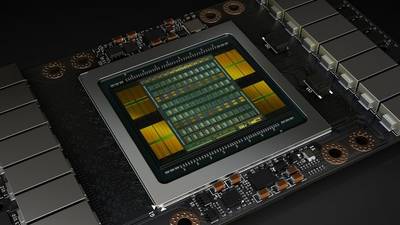
NVIDIA Launches Revolutionary Volta GPU Platform, Fueling Next Era of AI and High Performance Computing
"NVIDIA today launched Volta™ -- the world's most powerful GPU computing architecture, created to drive the next wave of advancement in artificial intelligence and high performance computing. The company also announced its first Volta-based processor, the NVIDIA® Tesla® V100 data center GPU, which brings extraordinary speed and scalability for AI inferencing and training, as well as for accelerating HPC and graphics workloads. "Artificial intelligence is driving the greatest technology advances in human history," said Jensen Huang, founder and chief executive officer of NVIDIA, who unveiled Volta at his GTC keynote. "It will automate intelligence and spur a wave of social progress unmatched since the industrial revolution. "Deep learning, a groundbreaking AI approach that creates computer software that learns, has insatiable demand for processing power. Thousands of NVIDIA engineers spent over three years crafting Volta to help meet this need, enabling the industry to realize AI's life-changing potential," he said. Volta, NVIDIA's seventh-generation GPU architecture, is built with 21 billion transistors and delivers the equivalent performance of 100 CPUs for deep learning. It provides a 5x improvement over Pascal™, the current-generation NVIDIA GPU architecture, in peak teraflops, and 15x over the Maxwell™ architecture, launched two years ago. This performance surpasses by 4x the improvements that Moore's law would have predicted." [...]
Outras Notícias
- Five Ways Quantum Computing Will Change the Way We Think About Computing
- Allegro MicroSystems, LLC Announces New High Current Integrated DC Motor Driver IC
- New PIC32 Family of 32-Bit Microcontrollers Optimized for Motor Control and General Purpose Applications
- SpaceX Static-Fires Falcon Heavy Core for 1st Time
Ciência e Tecnologia

Deep Learning Helps Scientists Keep Track of Cell’s Inner Parts
"Donnelly Centre researchers have developed a deep learning algorithm that can track proteins, to help reveal what makes cells healthy and what goes wrong in disease. “We can learn so much by looking at images of cells: how does the protein look under normal conditions and do they look different in cells that carry genetic mutations or when we expose cells to drugs or other chemical reagents? People have tried to manually assess what’s going on with their data but that takes a lot of time,” says Benjamin Grys, a graduate student in molecular genetics and a co-author on the study. Dubbed DeepLoc, the algorithm can recognize patterns in the cell made by proteins better and much faster than the human eye or previous computer vision-based approaches. In the cover story of the latest issue of Molecular Systems Biology, teams led by Professors Brenda Andrews and Charles Boone of the Donnelly Centre and the Department of Molecular Genetics, also describe DeepLoc’s ability to process images from other labs, illustrating its potential for wider use. From self-driving cars to computers that can diagnose cancer, artificial intelligence (AI) is shaping the world in ways that are hard to predict, but for cell biologists, the change could not come soon enough. Thanks to new and fully automated microscopes, scientists can collect reams of data faster than they can analyze it." [...]
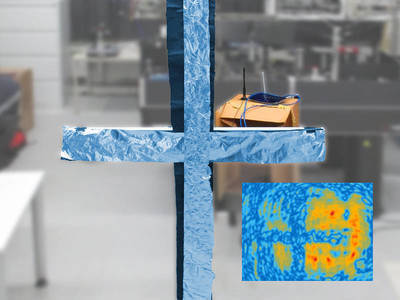
Holography with the Wi-Fi-router
"Scientists at the Technical University of Munich (TUM) have developed a holographic imaging process that depicts the radiation of a Wi-Fi transmitter to generate three-dimensional images of the surrounding environment. Industrial facility operators could use this to track objects as they move through the production hall. Just like peering through a window, holograms project a seemingly three-dimensional image. While optical holograms require elaborate laser technology, generating holograms with the microwave radiation of a Wi-Fi transmitter requires merely one fixed and one movable antenna, as Dr. Friedenmann Reinhard and Philipp Holl report in the current issue of the renowned scientific journal Physical Review Letters. “Using this technology, we can generate a three-dimensional image of the space around the Wi-Fi transmitter, as if our eyes could see microwave radiation,” says Friedemann Reinhard, director of the Emmy Noether Research Group for Quantum Sensors at the Walter Schottky Institute of the TU Munich. The researchers envision fields of deployment especially in the domain of industry 4.0 – automated industrial facilities, in which localizing parts and devices is often difficult." [...]
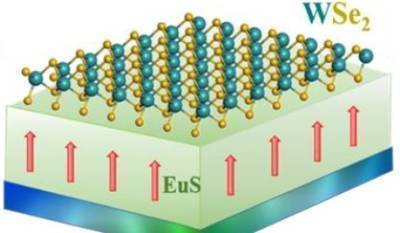
“Valleytronics” advancement could help extend Moore’s Law
"In the world of semiconductor physics, the goal is to devise more efficient and microscopic ways to control and keep track of 0 and 1, the binary codes that all information storage and logic functions in computers are based on. A new field of physics seeking such advancements is called valleytronics, which exploits the electron’s “valley degree of freedom” for data storage and logic applications. Simply put, valleys are maxima and minima of electron energies in a crystalline solid. A method to control electrons in different valleys could yield new, super-efficient computer chips. A University at Buffalo team, led by Hao Zeng, PhD, professor in the Department of Physics, worked with scientists around the world to discover a new way to split the energy levels between the valleys in a two-dimensional semiconductor. The work is described in a study published online today (May 1, 2017) in the journal Nature Nanotechnology. The key to Zeng’s discovery is the use of a ferromagnetic compound to pull the valleys apart and keep them at different energy levels. This leads to an increase in the separation of valley energies by a factor of 10 more than the one obtained by applying an external magnetic field." [...]
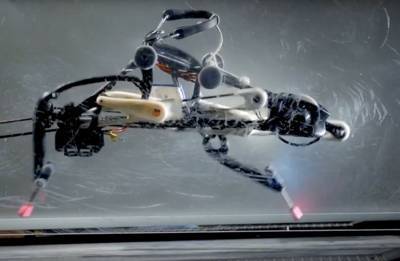
An Ostrich-Like Robot Pushes the Limits of Legged Locomotion
"What looks like a tiny mechanical ostrich chasing after a car is actually a significant leap forward for robot-kind. The clever and simple two-legged robot, known as the Planar Elliptical Runner, was developed at the Institute for Human and Machine Cognition in Pensacola, Florida, to explore how mechanical design can be used to enable sophisticated legged locomotion. A video produced by the researchers shows the robot being tested in a number of situations, including on a treadmill and running behind and alongside a car with a helping hand from an engineer. In contrast to many other legged robots, this one doesn’t use sensors and a computer to help balance itself. Instead, its mechanical design provides dynamic stability as it runs. “All the intelligence is in the physical design of the robot itself,” says Jerry Pratt, a senior research scientist at IHMC who leads the team that developed the robot. Pratt's group at IHMC is working on a range of different robots. The design might feed into future systems. “We believe that the lessons learned from this robot can be applied to more practical running robots to make them more efficient and natural looking,” Pratt adds. “Running will be eventually useful for any application that you want to do quickly and where wheels can't work well.”" [...]

CMU Creating touchpads with can of spray paint
"Touch sensing is most common on small, flat surfaces such as smartphone or tablet screens. Researchers at Carnegie Mellon University, however, turn surfaces of a wide variety of shapes and sizes into touchpads using tools as simple as a can of spray paint. Walls, furniture, steering wheels, toys and even Jell-O can be turned into touch sensors with the technology, dubbed Electrick. The "trick" is to apply electrically conductive coatings or materials to objects or surfaces or to craft objects using conductive materials. By attaching a series of electrodes to the conductive materials, researchers showed they could use a well-known technique called electric field tomography to sense the position of a finger touch. "For the first time, we've been able to take a can of spray paint and put a touch screen on almost anything," said Chris Harrison, assistant professor in the Human-Computer Interaction Institute (HCII) and head of the Future Interfaces Group. The group will present Electrick at CHI 2017, the Conference on Human Factors in Computing Systems, this week in Denver, Colo. Until now, large touch surfaces have been expensive and irregularly shaped or flexible touch surfaces have been largely available only in research labs. Some methods have relied on computer vision, which can be disrupted if a camera's view of a surface is blocked. The presence of cameras also raises privacy concerns." [...]
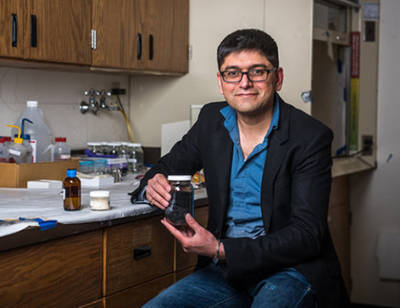
Engineer patents waterlike polymer to create high-temperature ceramics
"Ceramic textiles, improved jet engine blades, 3-D printed ceramics and better batteries may soon become a reality, thanks to a recently patented polymer from a Kansas State University engineer. Using five ingredients—silicon, boron, carbon, nitrogen and hydrogen—Gurpreet Singh, Harold O. and Jane C. Massey Neff associate professor of mechanical and nuclear engineering, has created a liquid polymer that can transform into a ceramic with valuable thermal, optical and electronic properties. The waterlike polymer, which becomes a ceramic when heated, also can be mass-produced." [...]
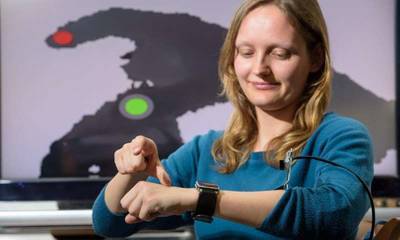
Operating smart devices from the space on and above the back of your hand
"It relies on a depth sensor that tracks movements of the thumb and index finger on and above the back of the hand. In this way, not only can smartwatches be controlled, but also smartphones, smart TVs and devices for augmented and virtual reality. They're called the "Apple Watch Series 2", "LG Watch", "Samsung GEAR S3" or "Moto 360 2nd Gen" but they all have the same problem. "Every new product generation has better screens, better processors, better cameras, and new sensors, but regarding input, the limitations remain," explains Srinath Sridhar, a researcher in the Graphics, Vision and Video group at the Max Planck Institute for Informatics. Together with Christian Theobalt, head of the Graphics, Vision and Video group at MPI, Anders Markussen and Sebastian Boring at the University of Copenhagen and Antti Oulasvirta at Aalto University in Finland, Srinath Sridhar has therefore developed an input method that requires only a small camera to track fingertips in mid-air, and touch and position of the fingers on the back of the hand. This combination enables more expressive interactions than any previous sensing technique. Regarding hardware, the prototype, which the researchers have named "WatchSense", requires only a depth sensor, a much smaller version of the well-known "Kinect" game controller from the Xbox 360 video game console. With WatchSense, the depth sensor is worn on the user's forearm, about 20cm from the watch. As a sort of 3D camera, it captures the movements of the thumb and index finger, not only on the back of the hand but also in the space over and above it. The software developed by the researchers recognizes the position and movement of the fingers within the 3D image, allowing the user to control apps on smartphones or other devices. "The currently available depth sensors do not fit inside a smartwatch, but from the trend it's clear that in the near future, smaller depth sensors will be integrated into smartwatches," Sridhar says." [...]
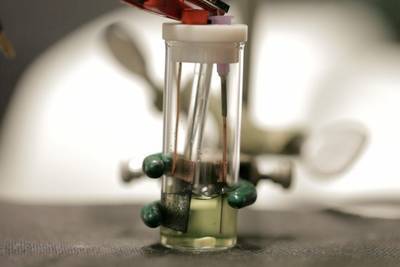
MIT researchers develop new way to clear pollutants from water
"When it comes to removing very dilute concentrations of pollutants from water, existing separation methods tend to be energy- and chemical-intensive. Now, a new method developed at MIT could provide a selective alternative for removing even extremely low levels of unwanted compounds. The new approach is described in the journal Energy and Environmental Science, in a paper by MIT postdoc Xiao Su, Ralph Landau Professor of Chemical Engineering T. Alan Hatton, and five others at MIT and at the Technical University of Darmstadt in Germany. The system uses a novel method, relying on an electrochemical process to selectively remove organic contaminants such as pesticides, chemical waste products, and pharmaceuticals, even when these are present in small yet dangerous concentrations. The approach also addresses key limitations of conventional electrochemical separation methods, such as acidity fluctuations and losses in performance that can happen as a result of competing surface reactions." [...]
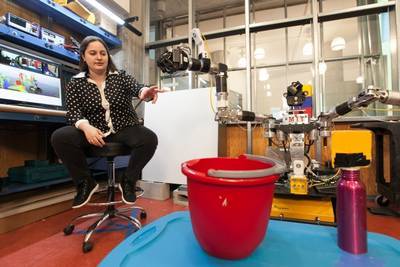
Teaching robots to teach other robots
"Most robots are programmed using one of two methods: learning from demonstration, in which they watch a task being done and then replicate it, or via motion-planning techniques such as optimization or sampling, which require a programmer to explicitly specify a task’s goals and constraints. Both methods have drawbacks. Robots that learn from demonstration can’t easily transfer one skill they’ve learned to another situation and remain accurate. On the other hand, motion planning systems that use sampling or optimization can adapt to these changes but are time-consuming, since they usually have to be hand-coded by expert programmers. Researchers from MIT’s Computer Science and Artificial Intelligence Laboratory (CSAIL) have recently developed a system that aims to bridge the two techniques: C-LEARN, which allows noncoders to teach robots a range of tasks simply by providing some information about how objects are typically manipulated and then showing the robot a single demo of the task. Importantly, this enables users to teach robots skills that can be automatically transferred to other robots that have different ways of moving — a key time- and cost-saving measure for companies that want a range of robots to perform similar actions." [...]
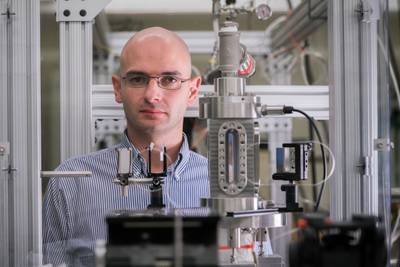
Matteo Bucci: Using nanotech to produce more megawatts
"What if the 450 nuclear power plants currently operating around the world could increase their energy output by 10 percent? It would represent a significant increase in carbon-free power production and the equivalent of billions of dollars in plant operation and construction cost savings. It's also the primary research goal of newly-appointed Department of Nuclear Science and Engineering (NSE) Assistant Professor Matteo Bucci. The output boost would be accomplished by using microtechnology and nanotechnology to re-engineer the outer surface of reactor fuel rods to prevent bubbles in cooling water from coalescing on the rods’ surface, where they form dry patches that lead to failure. This would ensure the efficient transfer of heat from rod to water under a wider range of conditions, which in turn would allow reactors to run at higher power and produce more electricity while preserving wide safety margins. “It’s a way of getting more juice from the same lemon,” explains Bucci, who began his affiliation with NSE as a visiting scientist in 2013. Bucci was named a research scientist in 2015, earned his faculty appointment in the fall of 2016 and has participated for several years in the MIT Center for Advanced Nuclear Energy Systems (CANES), which is hosting the research effort. In a show of strong industry interest, Bucci and his project teammate, Evelyn Wang, an associate professor in the Department of Mechanical Engineering, are being funded by energy giant Exelon. Fuel vendor Westinghouse Electric is also collaborating on the project. The corporate support (which also covers CANES research into several other improvements to fuel rod cladding) spans three years, and the technology could be ready for initial deployment within five years." [...]
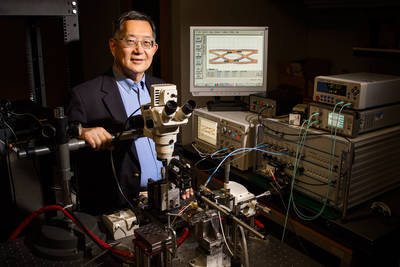
Researchers develop transistors that can switch between two stable energy states
"Engineers are unveiling an upgrade to the transistor laser that could be used to boost computer processor speeds – the formation of two stable energy states and the ability to switch between them quickly. Modern computers are limited by a delay formed as electrons travel through the tiny wires and switches on a computer chip. To overcome this electronic backlog, engineers would like to develop a computer that transmits information using light, in addition to electricity, because light travels faster than electricity. Having two stable energy states, or bistability, within a transistor allows the device to form an optical-electric switch. That switch will work as the primary building block for development of optical logic – the language needed for future optical computer processors to communicate, said Milton Feng, the Nick Holonyak Jr. Emeritus Chair in electrical and computer engineering and the team lead in a recent study." [...]
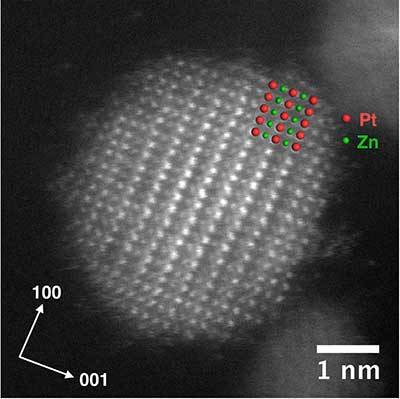
Ames Laboratory and Iowa State University scientists develop more efficient catalytic material for fuel cell applications
"Scientists at Ames Laboratory have discovered a method for making smaller, more efficient intermetallic nanoparticles for fuel cell applications, and which also use less of the expensive precious metal platinum. The researchers succeeded by overcoming some of the technical challenges presented in the fabrication of the platinum-zinc nanoparticles with an ordered lattice structure, which function best at the small sizes in which the chemically reactive surface area is highest in proportion to the particle volume. “That surface-to-volume ratio is important in getting the most out of an intermetallic nanoparticle,” said Wenyu Huang, Ames Laboratory scientist and assistant professor of Chemistry at Iowa State University. “The smaller the particle, the more surface there is, and more surface area increases the catalytic activity.” But the high temperature of the annealing process necessary to form intermetallic nanoparticles often defeats the goal of achieving a small size." [...]
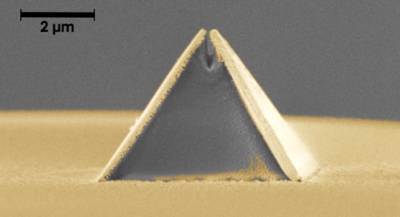
Scientists Print Nanoscale Imaging Probe onto Tip of Optical Fiber
"Combining speed with incredible precision, a team of researchers has developed a way to print a nanoscale imaging probe onto the tip of a glass fiber as thin as a human hair, accelerating the production of the promising new device from several per month to several per day. The high-throughput fabrication technique opens the door for the widespread adoption of this and other nano-optical structures, which squeeze and manipulate light in ways that are unachievable by conventional optics. Nano-optics have the potential to be used for imaging, sensing, and spectroscopy, and could help scientists improve solar cells, design better drugs, and make faster semiconductors. A big obstacle to the technology’s commercial use, however, is its time-consuming production process. The new fabrication method, called fiber nanoimprinting, could unplug this bottleneck. It was developed by scientists at the Molecular Foundry, located at the Department of Energy’s Lawrence Berkeley National Laboratory (Berkeley Lab), in partnership with scientists from Hayward, California-based aBeam Technologies. Their research is reported online May 10 in the journal Scientific Reports." [...]
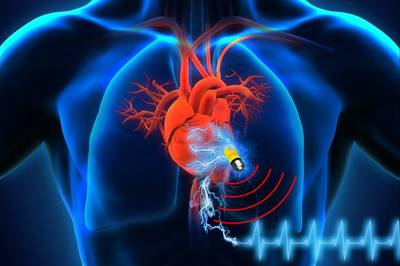
Battery-free implantable medical device draws energy directly from human body
"Researchers from UCLA and the University of Connecticut have designed a new biofriendly energy storage system called a biological supercapacitor, which operates using charged particles, or ions, from fluids in the human body. The device is harmless to the body’s biological systems, and it could lead to longer-lasting cardiac pacemakers and other implantable medical devices. The UCLA team was led by Richard Kaner, a distinguished professor of chemistry and biochemistry, and of materials science and engineering, and the Connecticut researchers were led by James Rusling, a professor of chemistry and cell biology. A paper about their design was published this week in the journal Advanced Energy Materials. Pacemakers — which help regulate abnormal heart rhythms — and other implantable devices have saved countless lives. But they’re powered by traditional batteries that eventually run out of power and must be replaced, meaning another painful surgery and the accompanying risk of infection. In addition, batteries contain toxic materials that could endanger the patient if they leak. The researchers propose storing energy in those devices without a battery. The supercapacitor they invented charges using electrolytes from biological fluids like blood serum and urine, and it would work with another device called an energy harvester, which converts heat and motion from the human body into electricity — in much the same way that self-winding watches are powered by the wearer’s body movements. That electricity is then captured by the supercapacitor." [...]
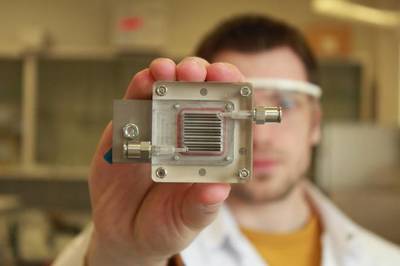
Polluted air can generate power
"Researchers from the University of Antwerp and KU Leuven have succeeded in developing a process that purifies air and, at the same time, generates power. The device must only be exposed to light in order to function. “We use a small device with two rooms separated by a membrane,” explains Professor Sammy Verbruggen (UAntwerp/KU Leuven). “Air is purified on one side, while on the other side hydrogen gas is produced from a part of the degradation products. This hydrogen gas can be stored and used later as fuel, as is already being done in some hydrogen buses, for example." In this way, the researchers respond to two major social needs: clean air and alternative energy production. The heart of the solution lies at the membrane level, where the researchers use specific nanomaterials. “These catalysts are capable of producing hydrogen gas and breaking down air pollution,” explains Professor Verbruggen. “In the past, these cells were mostly used to extract hydrogen from water. We have now discovered that this is also possible, and even more efficient, with polluted air.” It seems to be a complex process, but it is not: the device must only be exposed to light. The researchers’ goal is to be able to use sunlight, as the processes underlying the technology are similar to those found in solar panels. The difference here is that electricity is not generated directly, but rather that air is purified while the generated power is stored as hydrogen gas." [...]
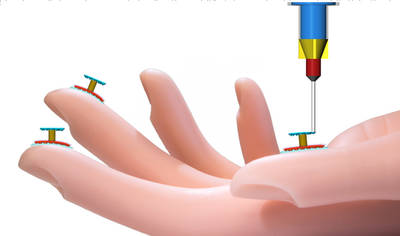
3-D Printing the Way to Bionic Humans
"Wearable technology may soon be at your fingertips -- literally. Researchers have developed a pressure sensor that can be 3-D printed directly on your hand. The device, sensitive enough to feel a beating pulse, is made from soft, stretchy silicone that conforms to the curves of your fingertip. It's a step toward a more seamless integration of human and machine, said Michael McAlpine, a materials scientist at the University of Minnesota in Minneapolis. His team didn't print the device on a real hand yet -- just an artificial one. "But," he said, "it sets the stage for future work in 3-D printing electronic devices directly on the body." Someday, that could mean technology evocative of the cyborgs and bionic humans of science fiction. In the nearer term, 3-D printed gadgets on and in the body could aid medical treatment, health monitoring and surgery. This 3-D printing approach, detailed today in the journal Advanced Materials, could produce gadgets without the cleanrooms and fancy equipment needed to make most devices today, McAlpine said. And as 3-D printers become cheaper and smaller, they might even become the Swiss army knives of the future." [...]
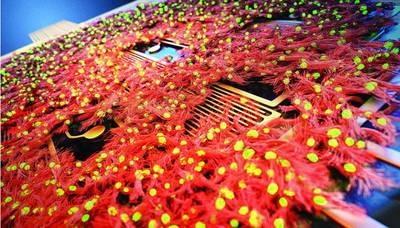
Lawrence Livermore unveils 'heart-on-a-chip'
"Prescription drugs have enabled millions of Americans with chronic medical conditions to live longer and more fulfilling lives, but many promising new drugs never make it to the human trials stage due to the potential for cardiac toxicity. Through "heart-on-a-chip" technology -- modeling a human heart on an engineered chip and measuring the effects of compound exposure on functions of heart tissue using microelectrodes -- Lawrence Livermore National Laboratory (LLNL) researchers hope to decrease the time needed for new drug trials and ensure potentially lifesaving drugs are safe and effective while reducing the need for human and animal testing. The research is part of the Lab's iCHIP (in-vitro Chip-Based Human Investigational Platform) project, which replicates human systems on engineered platforms to test the effects of toxic chemical and biological compounds. The research, published online on April 18 in the journal Lab on a Chip (link is external), describes the successful recording of both electrical signals and cellular beating from normal human heart cells grown on a multi-electrode array developed at the Lab. It is the first design, according to the researchers, capable of simultaneously mapping both the electrophysiology and contraction frequency of the cells." [...]
Modelos 3D
Com a disponibilidade de ferramentas que permitem dar azo a nossa imaginação na criação de peças 3D e espaços como o thingiverse para as publicar, esta rubrica apresenta alguns modelos selecionados que poderão ser úteis.
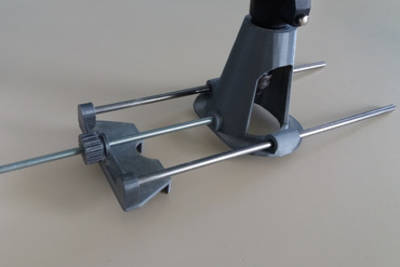
Router for Dremel
"This is a aouter accessory for dremel, with a guide. Two rods help to maintain the guide, while a threaded rod is used to trim the distance of the router cut. The router is screwed to the dremel." [...]
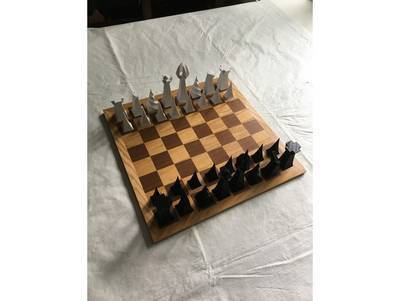
Parabolic Chess Set
"Chess set built mostly of parabolas. Designed using OpenSCAD with a generic parabola function that defines a polygon based on input width and height. STL files are scaled in inches to print a pawn with a 1"x1" base and the pieces with a 1.25"x1.25" base. One scad file lays out all of the pieces on a chess board. The other one is scaled and arranges the pieces onto a circular area for printing." [...]
Documentação
A documentação é parte essencial do processo de aprendizagem e a Internet além de artigos interessantes de explorar também tem alguma documentação em formato PDF interessante de ler. Todos os links aqui apresentados são para conteúdo disponibilizado livremente pelo editor do livro.
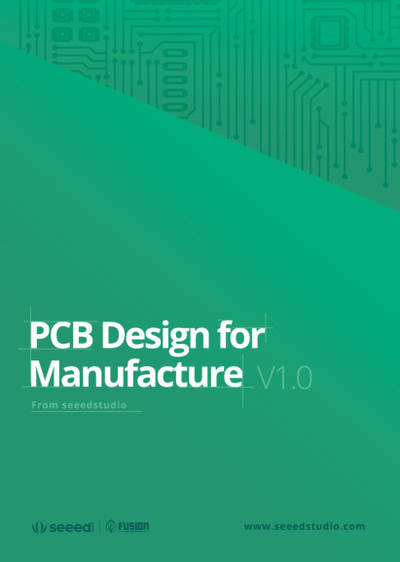
PCB Design for Manufacture v1.0
"Seeed is a hardware innovation platform for makers to grow inspirations into differentiating products and offersaccessible technologies with quality and delivery guarantee. Seeed Fusion Service offers one-stop prototypingservice for PCB, PCB Assembly service and other electronic and mechanicalcustomized services (like CNC Milling, stencil, 3D Printing, PCB Layout Service). Seeed has been in the electronics industry for more than 9 years and has accumulated a great deal ofmanufacturing experience. To help bridge the gap between design and manufacture and put into practice ourcompany values “ Grow the Difference”, which aims to help more people make their product come true, we havesummarized our 9 years of manufacturing experience in this manual. Since we are not a professional publisher, there may be some incorrect spellings or vague expression in thismanual, we really appreciate your feedback to help us improve the manual together. We will keep upgrading thismanual to make it beneficial to the whole community, if you have any advice or suggestions, please contact us at:([email protected]). For more information about the latest prototype service and specification, please head to our website www.seeedstudio.com . This specification defines the design parameters for PCB design from a DFM point of view, including the shape,lamination construction, Fiducial design, component layout, conductive traces, holes, solder mask, surfacetreatments, silk screen design, and so on." [...]
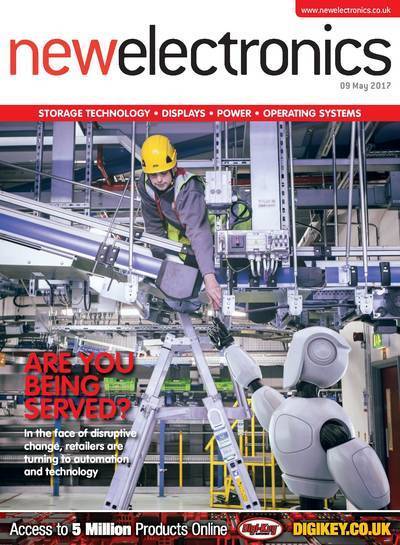
newelectronics 9 de Maio 2017
"New Electronics is a fortnightly magazine focusing on technological innovation, news and the latest developments in the electronics sector. Downloadable as a digital page turner or pdf file, or offered as a hard copy, the New Electronics magazine is available in a format to suit you." [...]
Projetos Maker
Diversos Projetos interessantes.
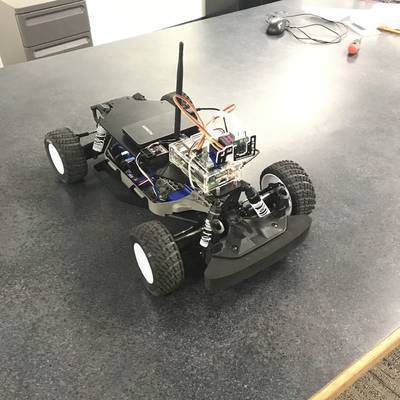
Raspberry Pi Remote Controlled Car
"This project modifies a Traxxas remote control car to be driven from a computer in a remote location. The car can be driven remotely while viewing its perspective through a camera mounted on the car. The car also utilizes a pan tilt motor that moves the camera around so that the user can see everything going on from where the car is. We implemented this project at our university where the wifi network was obtainable across the entire campus. This allowed us to drive the car anywhere that it could connect to the wifi. Realistically if you were to implement this project on your own you could control the car from your computer anywhere that is within reach of that same wifi signal. This instructable is laid out with the idea that if you were to implement this project, you would follow our steps exactly. There are many things that can be modified." [...]
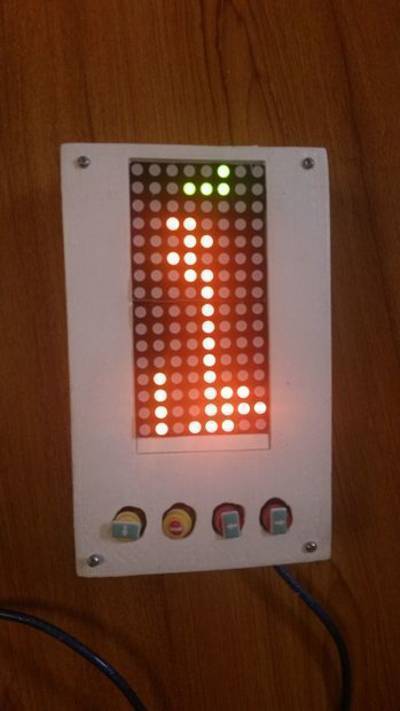
Tetris Uno
"The following Instruct-able shows the design process for the Tetris Uno project." [...]
Pixel
"Hi everyone, this is my first instructable. I was always fascinated by the awesomeness of LED's ,when I was a kid (Before I came to know about white LED on Nokia phone) once I asked my father if we keep red green and blue light pointed at same spot it would give white color can't we do the same with LED and make a TV? Well now its a reality. So now I wanted to take out a single Pixel out from the display, and change it color anywhere in the world. Once I have made this I will be able to control its color by lots of tools and devices. So Let's make this thing and get it connected to the internet (Internet of Things). To make vibrant colors I used 5050 RGB SMD LEDs for better color blending. So if you don't have it no worries, use normal 5mm RGB LEDs or separate R G B LEDs with proper diffuser, Even at my place its hard to find RGB SMD led so I savaged it from LED Strip. (I got 12v 5 meter RGB 5050 led strip for $9 or ₹550 in India). For communication I have used ESP8266 12E ($3 or aprox ₹200 from a local store) or you can use a Node MCU. I personally wanted to try SMD (Surface Mount Devices "Tiny components") for this project even through hole component will do just fine, and i wanted it to work in 5v so connecting a power bank could make it portable and many of us can't afford a Philips Hue Go. But you can make one similar." [...]
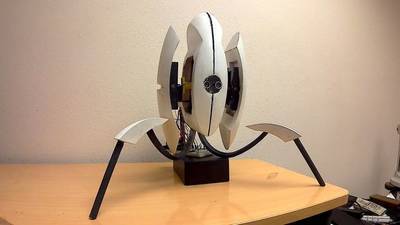
The Aperture Science Sentry Turret With an Arduino
"Ever since I first played Portal when it released on the Orange Box, I've always been obsessed with the game. The turrets in particular have remained my favorite characters in any game to date and I've always imagined how cool it would be to have one of my own. So when I signed up for the Makecourse at the University of South Florida, and they told me I could make my project whatever I wanted as long as it used an arduino and had a 3D printed part, the choice was very clear to me." [...]
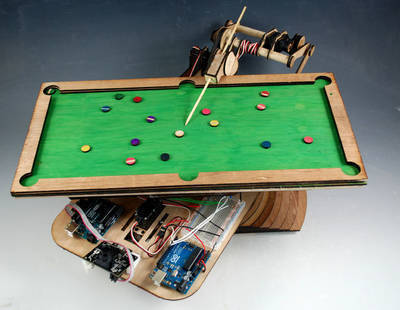
Pool Playing Robot
"I hope for the opportunity to do this kind of work with Instructables during this upcoming Artist in Residency session. If you like my project, please vote!! If you like the idea of me being considered for an artist in residence position, please vote!!! Thank you! Now, here is the story of the pool playing robot code named Judith." [...]
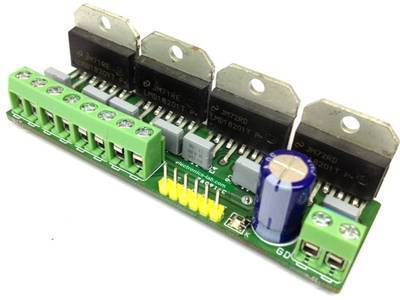
4 Wheel Robot Motor Driver ( 4X 3Amps LMD18201 H-Bridge)
"This compact board will help you to drive 4 Wheel Drive Robots, each axis can handle a load current up to 3 Amps and supply 12V – 48 V DC. Board requires two PWM and Dir. signals for full 4WD operations, mainly differential steering for taking turns left or right or complete 360 degree rotation. The module has been designed around LMD18201 from Texas Instruments. The LMD18201 is a 3A H-Bridge designed for motion control applications. The device is built using a multi-technology process which combines bipolar and CMOS control circuitry with DMOS power devices on the same monolithic structure. Ideal for driving DC and stepper motors; the LMD18200 accommodates peak output currents up to 6A. An innovative circuit which facilitates low-loss sensing of the output current has been implemented." [...]
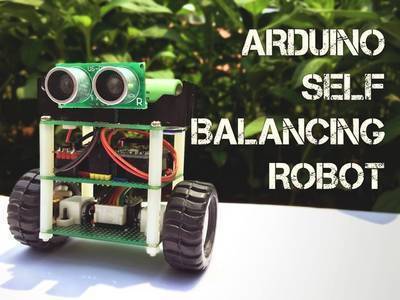
Arduino Self-Balancing Robot
"In this instructable, I'll show you how to build a small self-balancing robot that can move around avoiding obstacles. This is a tiny robot measuring 4 inches wide and 4 inches tall and is based on the Arduino Pro Mini development board and the MPU6050 accelerometer-gyroscope module. In the steps that follow, we will see how to interface the MPU6050 with Arduino, how to measure the angle of inclination of the robot, how to use PID to make the robot stay balanced. An ultrasonic rangefinder is also added to the robot which prevents it from banging into obstacles as it wanders around." [...]
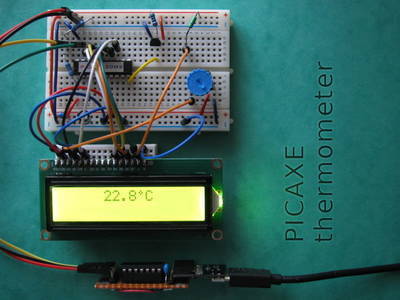
PICAXE Thermometer Prototype With DS18B20 Sensor and LCD Display
"When I learned Arduino basics, I saw some nice small hobby robots based on Arduino and also on PICAXE. I did not know about PICAXE at the time. But I quickly realized that PICAXE is very popular in hobby robotic communities. After some time I read a few interesting articles about the basic principles of PICAXE and I decided to try and explore PICAXE. It looked quite easy. In this instructable I'll show how to start program PICAXE, how to upload program into PICAXE and how to create a simple thermometer." [...]
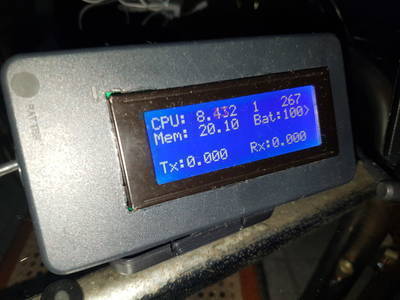
Computer Monitor Using Arduino and Node JS
"This instructables will show how to monitor your computer hardware while doing another things on your computer. I always had problem to check my hardware while playing games, programming and etc... that is why I decided to make this Computer Monitor using Arduino; I called it Retrovisor (Rearview mirror in portuguese). Using this you can check your CPU / memory usage, process running, stand by process, battery life and network usage without opening any screen on your computer. For this I used an old font case, arduino Duemilanove, 4x20 LCD and node.JS." [...]
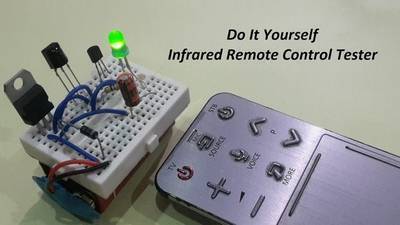
Infrared Remote Control Tester Using TSOP4838
"Here's how to build a simple remote control tester circuit. Just follow the steps below and you'll make it under 5 Minutes." [...]
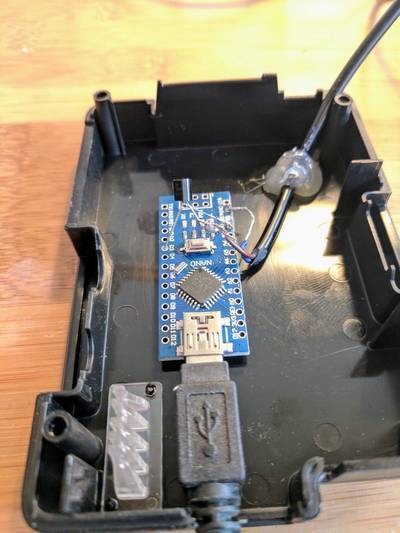
DIY Arduino powered Flash Trigger
"If you need to trigger a flash but you don’t find the satisfying app for your scope, you could do what Josh Beckwith did, making it from yourself. It’s a simple project, but it could be helpful for everyone with less experience with Arduino." [...]
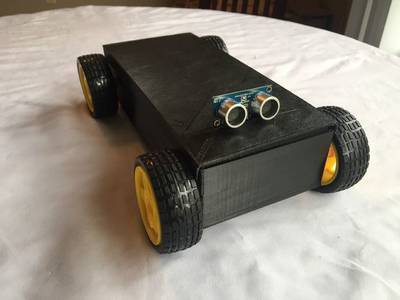
Arduino Controlled Car
"This project is a car that is programed to avoid any objects in front of it automatically, and then turn away from that object and keep on going." [...]
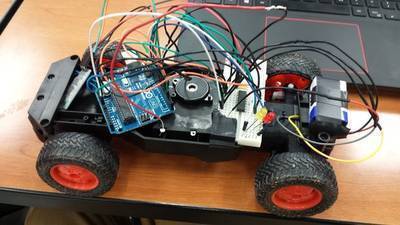
Bluetooth RC Car: Part 1
"In this tutorial you are going to learn how to hack a remote controlled car with an Arduino Uno so you can control it with your phone via Bluetooth. Using an Arduino allows other features to be added like a tail light, or a speaker. The wonderful thing about this system is that it a platform so you can add other features to the car. This is only part 1 because we were just focusing on getting the car to move since neither of us have ever done anything like this before. Part 2 should be coming closer to the end of the year, as we plan on working out a way to get two of these cars to interact with each other, either by command or autonomously." [...]
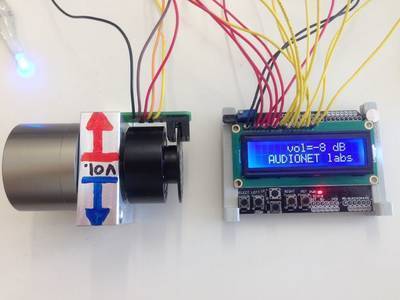
Rotary - Encoder Control With Ti Launchpad
"There are many cases where one needs a button, encoder, or a device to use it as a input for several settings. The rotary encoder having no physical connection to a circuitry is a very sophisticated and long term solution due to many reasons." [...]
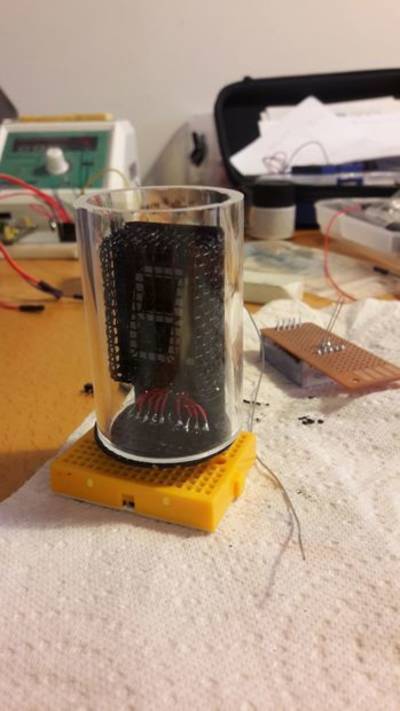
Nixie Inspired 7 Segment Display
"This Instructable is the first part of a bigger project : a desktop clock with 4 pseudo Nixie 7 segment digits. I decided to publish a dedicated Instrcutable for the Nixie because I was highly inspired by an article read on hackaday (http://hackaday.com/2015/03/03/nixie-inspired-7-segment-display/). Here is my version which looks promising. Stay tuned for the desktop clock. The 7 segment is a one inch high 10016AS model. I will use a plexiglass tube to make it look like a nixie tube." [...]
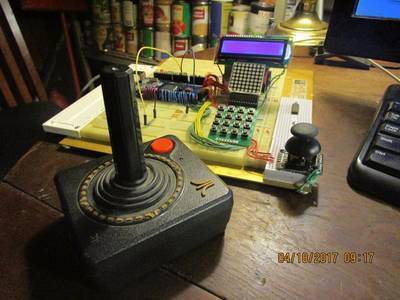
MEGA BREAD - Atari Joystick Linking for Robotics control
"For use with robotics control when completed as a whole project. The Joysticks are recovered from a by gone era of my time, 80's when computers were just taking off. Anyway, these Joysticks are Infrared, They work, and both have different signals, but on the same timings frequency. One of them is a master having the reset, next, and select menu buttons on it. The other does not. Now to the usage video. These joysticks send out some funky monkey types of signals as you will see, I traced it down to three variables that needed to be worked out." [...]
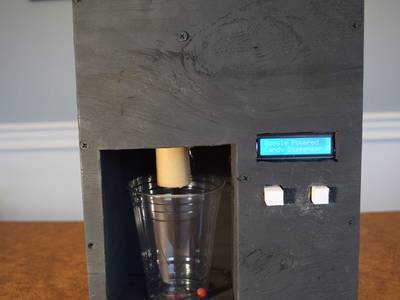
Candy Dispenser with Google Assistant
"By using IFTTT, the Google Assistant API, and a Particle Photon, you can make a machine that gives out candy upon your request! This is a comprehensive guide for building and using my Google Assistant Powered Candy Machine. It can be split up into these parts: Making and Using the Raspberry Pi with Google Assistant; Coding and Setting up the Particle Photon; Making an IFTTT Applet; Creating the Wooden Box and the Mechanical Parts; Coding the Arduino Mega 2560; Installing the Electronics; Testing and Usage." [...]
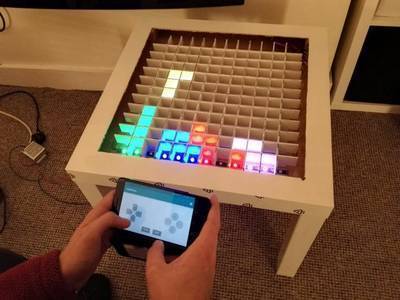
Bluetooth Controlled Arduino LED Coffee Table
"This was my first real Arduino project and is also my first instructable so be kind in the comments :) I wanted to try and answer the questions that took me some time to figure out and provide detailed instructions so if you're very familiar with hobbyist electronics then you can probably skim through each step but if you're new to this it should provide you with everything you need. The aim of the project was to create a 12 x 12 pixel screen in a coffee table that can be controlled via bluetooth and used as a cool room light/play games on it." [...]
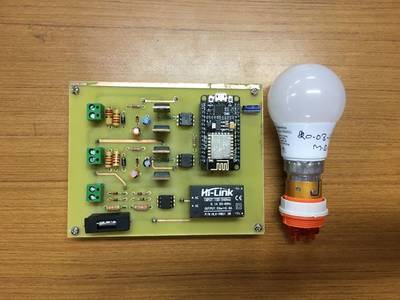
Multichannel Wireless Light Dimmer
"By using a light dimmer in one’s living room, it’s possible to completely alter the mood and ambience of a room at the drop of a hat. The Internet of Things is set to disrupt the way we live and work. Smart homes filled with connected products are loaded with possibilities to make our lives easier, more convenient, and more comfortable. With Wi-Fi connectivity present in the dimming controller, the above benefits get reflected in this module. However, this actually carries with it a host of less obvious but equally favorable benefits such as reduced energy consumption and improved longevity - longer the bulbs are dimmed, lesser the energy they use and longer they last." [...]
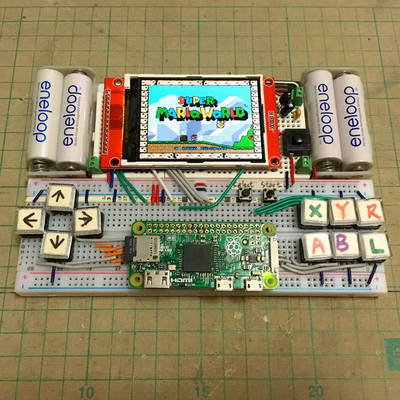
Breadboard RetroPie
"This Instructables show how to build a Breadboard RetroPie, no soldering, no 3D printer, no Laser cutter required. Building a game machine is a very good project to initial child studying electronics. However, most RetroPie projects built by adult, the main reason is building it require too many advance skills at the same time, soldering, 3D printing, or Laser cutting, metal case patching... This project aims to make it simple, all things built on the breadboard, the first tools you should know while studying electronics. The most beauty thing using breadboard is most things can be reused. When you want to build the next project you can unplug and reuse the components and also reuse the breadboard itself!" [...]
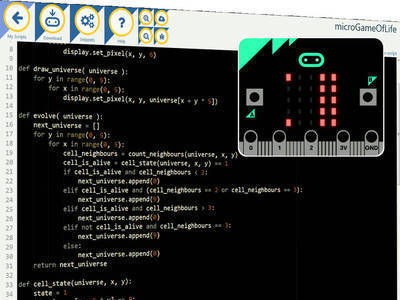
Conway's Game of Life
"In this implementation the universe is a toroidal 5x5 grid, this means the top 5 cells are adiacent with the bottom 5 cells, the same for the left and right cells. With a so small space available some patterns acts in a strange way, we start exploring it." [...]
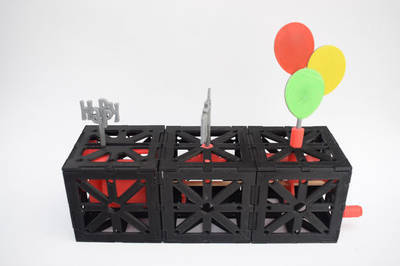
Modular Automata
"An automaton is a self-operating machine, or a machine or control mechanism designed to automatically follow a predetermined sequence of operations, or respond to predetermined instructions. (obtained from wikipedia) As soon as I saw my very first automata I wanted to know how they work and if possible build my own. With this in mind, sometime ago I built a kit for 3D priting that allowed me to do that and called it simply Modular Automata. This design consists on a set of independent boxes, each one able do execute a type of motion, linear along the x axis, linear along the z axis and rotational. You can print and combine several of these boxes and add signs to them for that extra bit of customization, finally you simply turn a small knob and that motion is transmitted through all boxes thus bringing your custom automata to life. That project was designed in my software of choice at the time, Rhinoceros, but more recently I've been dabbling in Fusion 360 and this project seemed a perfect fit for Fusion 360 due to it's parametric nature, while I do like Rhino, it's a pain to change part of a design, that same task in Fusion 360 usually does not require much more than right-clicking on the feature and changing the required value. So for this instructable, I will show how I converted my original design from Rhinoceros to Fusion 360." [...]
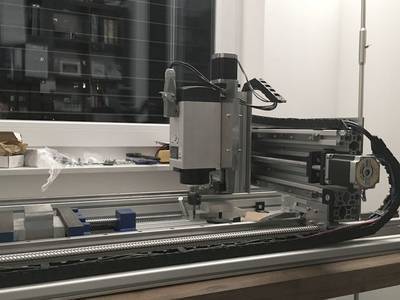
3 Axis CNC Milling Machine
"For lots of projects a CNC milling machine is necessary for good and fast results. After some research about current available machines I came to the conclusion that all machines in a price frame of up to 2000€ can not fulfill my needs regarding working space and accuracy." [...]
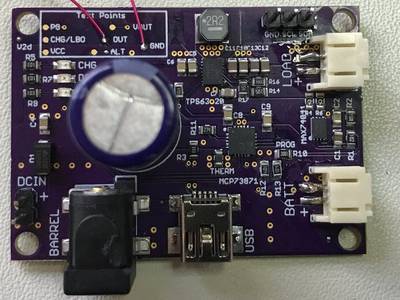
Solar Power Module v2
"Single board to control solar charging and battery monitoring for your outdoor projects. Your project will see a perpetually charged battery. I build connected sensor which are often deployed in local parks where there is no access to utility power. Over the past couple years, I have been refining and testing my solar power modules and have arrived at this compact integrated design. I have a number of these deployed and they have been in continuous service for up to two years. I wanted to share this design in case it might be helpful for your projects. I would also greatly appreciate any input or suggestions on this design so v3 will be even better." [...]
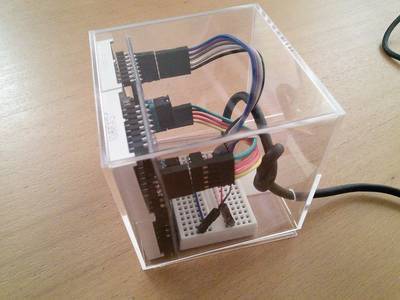
Conway's Life of Life of 16×16 Cells Made With ATtiny13A
"I challenged making a Conway's Game of Life at 1 KB using ATtiny13A.It was used to display four MAX7219 LED Dot Matrix Display Modules. In order to display 16×16 Dots I reviewed the sketch and made improvements to make effective use of less memory. I improved the display to random and I was able to keep watching Game of Life. I feel pleasant to see cells that change in Game of Life :-)" [...]
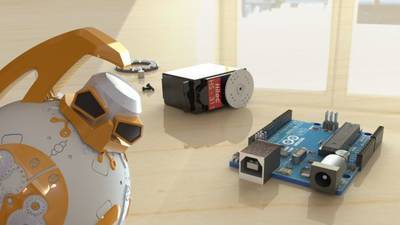
[How to Build a Robot From Scratch](How to Build a Robot From Scratch)
"Have you already though about building a robot that can be remotely controlled using your smartphone? If yes, this short intractable is for you! I will show you the step by step method that you can use for any of your projects to be able to start from an idea and create a complete robot or system by yourself. For this project, we will use the Arduino/Genuino 101 board to create our Robot. So, let's just Make it!" [[...]](How to Build a Robot From Scratch)
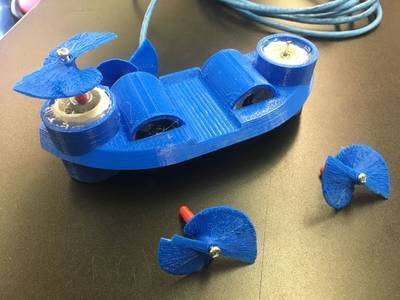
DC Motor ROV
"A ROV using DC motors and an Ethernet cable." [...]
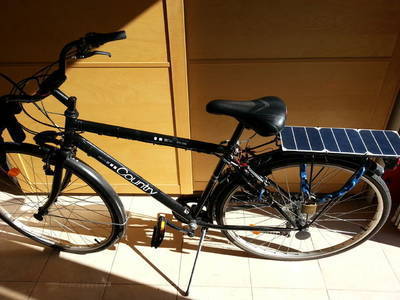
DIY 5V Solar Bike
"Hi, today we will make a lightweigh and completely sun powered solar bike, of course it will not be so much powerful as common bikes, often you have to pedal but you don't need to charge or move heavy batteries." [...]
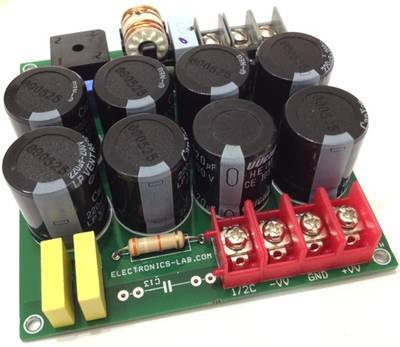
400V – 5A Power Supply For Brushless Motor Drivers
"Although the power supply design is specific to the Brushless Servo Drivers mainly for IPM Modules, the concepts and circuit design may be used for any power supply requires high voltage output up to 400V DC and 5 Amps. The power supply is an unregulated design with an option to allow connection to either 120V or 230V mains and also it can work with lower voltage for audio amplifiers by increasing capacitor value. The design uses fully integrated bridge rectifier, and multiple bus capacitors for low ripple, noise suppression, and provides high current reservoirs. Additionally the dc supply line have bleeder resistor R2 and R3 to drain the large reservoir capacitors PCB, mounted fuse holder provided for short circuit and over current protections, low ohm NTC used for inrush current at power start up, C1, C12, TX protects against turn on/off spikes and EMI noise reduction. This power supply can be used to drive Tesla Coils, Induction heaters, DC Motor drivers, Brushless DC motor driver." [...]
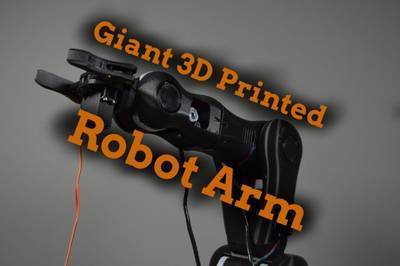
Build a Giant 3D Printed Robot Arm
"Have you ever wanted to build a giant, 6-axis, mostly-3D-printed robot arm? Well, this Instructable will show you how to do exactly that. Using a large collection of 3D printed parts, stepper motors, a 3D printer control board, a power supply, and a big pile of off-the-shelf hardware, we will create a large and powerful robot arm." [...]
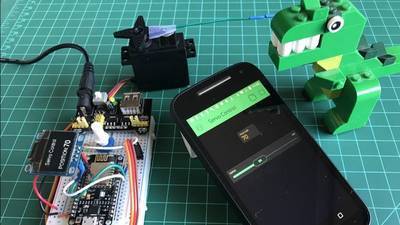
IoT Made Simple: Servo Control With NodeMCU and Blynk
"In this simple tutorial, we will explore how to control a servo over the internet. For that, we will use a great couple of devices, the NodeMCU ESP12-E and a Blynk App. We will start learning how to connect the servo with the NodeMCU, knowing how to control it locally with a potentiometer, how to see its position on an OLED display and finally how to control it over the internet using a smartphone. The Block diagram gives us an overview of what will be the final project." [...]
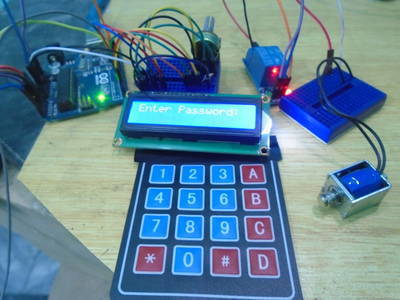
Arduino Keyless Door Lock System with Keypad and LCD
"In this project, we are going to make a keyless door lock system which uses a 4X4 keypad to enter the keys and a DC lock to open or close the door. A 16X2 LCD will be used for display." [...]
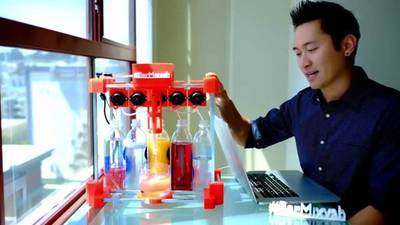
Build your very own drink mixing robot!
"I built a robot that mixes drinks named Bar Mixvah. It utilizes an Arduino microcontroller switching a series of pumps via transistors on the physical layer, and the MEAN stack (MongoDB, Express.js, Angular.js, Node.js) and jQuery for the frontend and backend. In this post, I’ll teach you how I made it. You can follow along and build one just like it! I’ve also put the 3d model (blender), stl files, and the code up on GitHub for you guys to download. " [...]
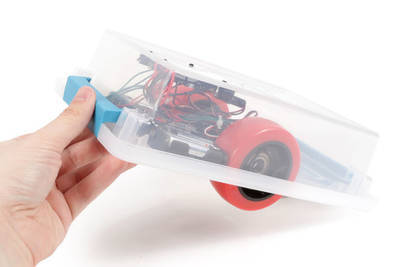
Telepresence Robot: Basic Platform (Part 1)
"A telepresence robot is a type of robot that can be controlled remotely over the internet and function as a surrogate for someone somewhere else. For instance, if you are in New York, but want to physically interact with a team of people in California, you could call into a telepresence robot in California and have the robot be your stand-in. This is the first part of a seven-part instructables series. Over the next two instructables we will be building the basic electromechanical robot platform. This platform will later be enhanced with sensors and additional control electronics. This base is centered around a plastic box which both provides structure, and offers internal space for storing electronics. The design uses two center drive wheels attached to continuous servos which allow it to go forwards, backwards, and pivot in place. To keep it from tipping side-to-side, it incorporates two metal chair gliders. The whole thing is controlled by an Arduino." [...]
EAL - Arduino MIDI Controller
"This instructable describes an arduino based MIDI controller. This is a school project. By using your hand you can play simple melodies via the MIDI connection and a connected MIDI instrument (or as in this case a notebook running a softsynth software). To be able to connect the MIDI controller to a notebook, you will need a MIDI to USB interface like m-audio Uno." [...]
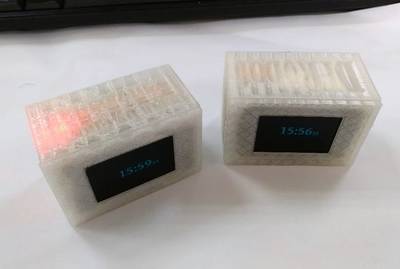
How to Make a Smart Clock
"I’ve always been dreaming of making a desktop clock which without complex functions, just smaller and can display time. Here is what I think: Features: Small and convenient; Inertial conduction, sensing the placement of clock; Charging Function. My clock has the function of charging, using micro USB (any mobile phone charger can be used) for charging. Don’t worry about running out of power (unless you are too lazy to charge it...). I will show you the whole making procedures and source codes in the following." [...]
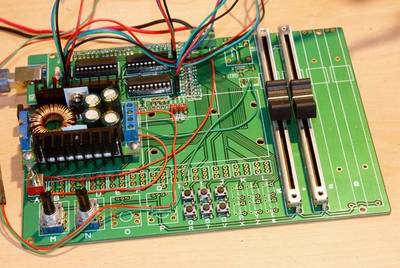
Simple Manual Arduino 4 Axis Stepper Motor / 16 Channel LED Power Controller
"Supplying power to motors and LEDs is not always just a case of connecting to a battery and flicking a switch. Sometimes we need to control the speed of motors and be able to dim LEDs for a romantic mood effect, which is often achieved by pulsing the motor / LED with a voltage at a specific frequency (PWM). If we tried to run the motor directly off a PWM pin on an Arduino we would soon smell the tale-tale scent of burning silicon and maybe even see a small flame being emitted, which is obviously a bit of a fire hazard! The controller needs to not only pulse the motor windings with the Arduino, but also needs to bring current in from a fairly robust auxiliary power supply. This is achieved by using a set of 4 integrated circuits containing power transistors, resistors and diodes, all in contained within the four neat little packages. A manually controlled lighting system is great for setting moods, where you can get exactly the right lighting level for a romantic evening, but stepper motors have some seriously useful applications and to be able to control them manually, without using a computer, effectively gives you an incredible level of precision control, quite literally, at your finger tips. Some engineering and medical jobs need to be done on a high precision microscopic level. Maybe you want to accurately place miniature components on a circuit board or perform a high precision surgical operation or experiment with genetic engineering under an electron microscope? Some jobs are just too small and delicate to be done by hand without assistance from a machine. For example, this controller could move a surgeon's scalpel to 1/100 th of a mm accuracy (or better) using your fingers. But the best thing of all is that it's incredibly easy to build - A reasonably clever 12 year old would have no problems building this controller - perfect for any budding brain surgeon! There are no SMT components to solder, no complicated programming, no software drivers to drive you crazy - just a few cheap components, most importantly the STMicroelectronics L293E, and an Arduino Mega or Due. Just because this design is simple does not mean that it's not incredibly useful. It can be used to control a16 channel lighting system with a honking great 1A per channel - yes that's 16A total - and as a general purpose slider / rotary pot / toggle switch / push button Arduino interface and for precision control of stepper motors. So, the next time you go in for a frontal lobotomy, your surgeon may well be using one or two of these controllers and a couple of Arduinos to not only do the surgical operation but also to control the mood lighting for a nice relaxing environment!" [...]
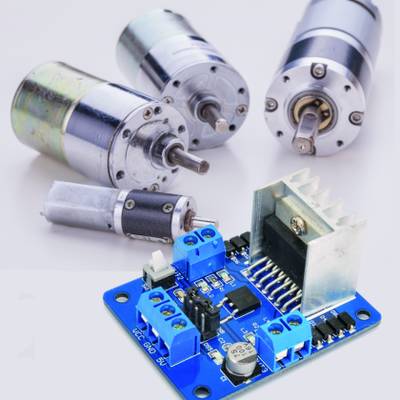
A DC Motor Controller with Control Leds
"It can be controlled through logic levels to set the speed and the direction of the rotation of CC brushed motors and stepper motors; outputs have LEDs indicating the rotation direction. The circuit board we are presenting this time is based on the dual-bridge driver L298N, in a traditionally mounted version in a Multiwatt container with 15 staggered pins; it has two terminal blocks for attaching to DC motors or the coils of a bipolar stepper motor and a terminal block for powering logics and motors. Each of the two output channels of the circuit can provide a maximum current of 2 A, which is enough to drive two 2 A direct current motors or a bipolar stepper motor absorbing 2 A per phase." [...]
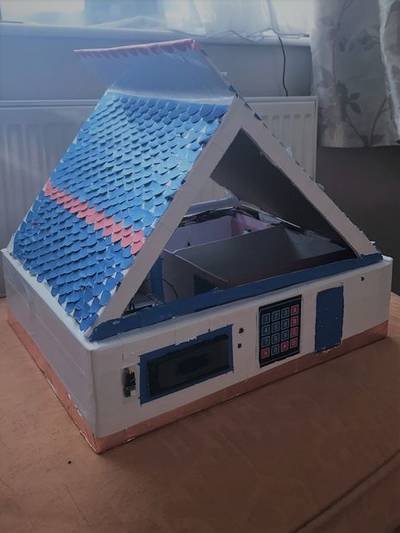
Arduino Home Security System
"This a Home Security System using Arduino Mega 2560, which will trigger alarm when any door is opened or movement detected in the room when the system is activated. Its a nice project for anyone in final year in the university. you can upgrade it even much better. will be here to help. Have fun!!" [...]
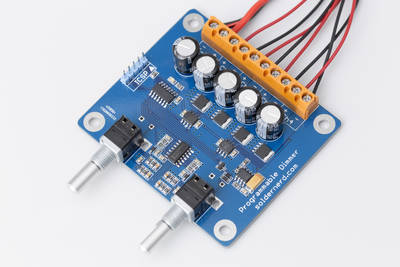
Programmable LED dimmer
"Around one and a half years ago I’ve designed and built various LED dimmers for both white and RGB LEDs. Then late last year someone approached me asking if I could make an RGB dimmer for him, too. But my designs were really tailored to their specific applications and built with home-made, i.e. milled PCBs which are time-consuming to make. So I decided to make a more universal version based on a proper, etched board which could be built in a small series and used for all kind of applications, both white and RGB. The result is this versatile, programmable 4-channel dimmer." [...]
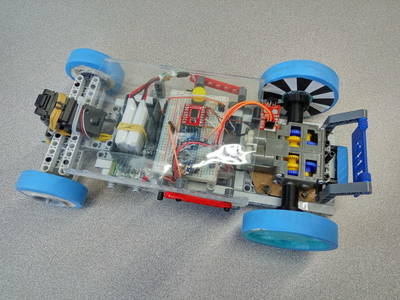
Bluetooth RC Drone Car
"If Apple made a car, would it have Windows? We don't know, but we know this Instructable is wheely cool! ;) Hello Guys! We are Mary and Rain, two students in Ms. Berbawy's Robotics class at Irvington High School. This Instructable is for our SIDE project in this class. In this project, we took a car built for the Science Olympiad Division C Electric Vehicle build event and modified it into an RC car that can be controlled via a phone application and take pictures/videos like a land drone. Although we also built the car ourselves and will show you the general steps of how it was done, this Instructable is more focused on the controller and electronics aspect, which we hope can be implemented to your own car designs (better than ours?). We hope you enjoy this Instructable and feel free to give any suggestions as it is our first Instructable! :)" [...]
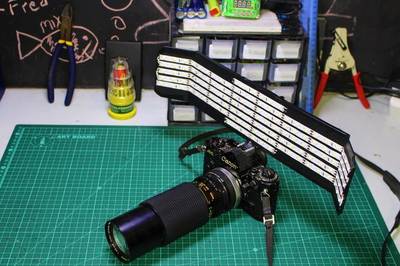
Portable Light Panel
"Good lighting is an essential part of video production and photography. Unfortunately achieving this lighting isn't always easy or cheap, in the past I've used everything from orange tinted desk lamps to led flashlights to try and provide better lighting for my photos and videos. That's why I decided to make a portable white led panel which can be used indoor while connected to a wall adaptor or used outdoors with a battery pack that we are going to build. Overall this is a pretty easy build which can be done even if you're electronics experience is low." [...]
That's all Folks!


